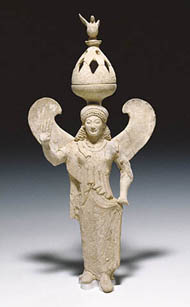1. Display the students' completed sculptures along with their preparatory drawings.
2. Bring back the criteria for a sculpture developed in Lesson 1. Have each student choose the work of a classmate and use
the criteria to write an evaluation of the artwork in his or her journal addressing the following questions.
• What symbols did the artist use?
• What do the symbols stand for?
• If the symbols are part of a larger subject, what do the symbols in the sculpture communicate about the subject of the sculpture?
• In your opinion, how effective are the symbolic elements in this work of art at conveying meaning?
• How does the medium that the artist chose affect your appreciation of this sculpture?
• If the artist hadn't been limited to specific mediums, is there another medium that you think he or she could have used?
What would the ideal medium for this sculpture be?
3. Ask the class which of the Getty artworks helped them solve their own design problems. Make sure they explain why and point
out which aspects of the Getty works helped them.
|
 |
 |
 |
| Thymiaterion Supported by a Statuette of Nike, Greek, 500–480 B.C. |
 |
|
 |
Common Core Standards for English Language Arts
Grades 9–12
WRITING
Text Types and Purposes
1. Write arguments to support claims in an analysis of substantive topics or texts, using valid reasoning and relevant and sufficient evidence.
Production and Distribution of Writing
4. Produce clear and coherent writing in which the development, organization, and style are appropriate to task, purpose, and audience.
SPEAKING AND LISTENING
Comprehension and Collaboration
1. Prepare for and participate effectively in a range of conversations and collaborations with diverse partners, building on others' ideas and expressing their own clearly and persuasively.
2. Integrate and evaluate information presented in diverse media and formats, including visually, quantitatively, and orally.
Visual Arts Content Standards for California Public Schools
Grades 9–12 Proficient
1.0 Artistic Perception
Develop Perceptual Skills and Visual Arts Vocabulary
1.1 Identify and use the principles of design to discuss, analyze, and write about visual aspects in the environment and in
works of art, including their own.
1.2 Describe the principles of design as used in works of art, focusing on dominance and subordination.
Analyze Art Elements and Principles of Design
1.4 Analyze and describe how the composition of a work of art is affected by the use of a particular principle of design.
Impact of Media Choice
1.5 Analyze the material used by a given artist and describe how its use influences the meaning of the work.
4.0 Aesthetic Valuing
Derive Meaning
4.1 Articulate how personal beliefs, cultural traditions, and current social, economic, and political contexts influence
the interpretation of the meaning or message in a work of art.
Make Informed Judgments
4.4 Articulate the process and rationale for refining and reworking one of their own works of art.
4.5 Employ the conventions of art criticism in writing and speaking about works of art.
National Standards for Visual Arts Education
Grades 9–12
2. Using knowledge of structures and functions
a. Demonstrate the ability to form and defend judgments about the characteristics and structures to accomplish commercial,
personal, communal, or other purposes of art.
b. Evaluate the effectiveness of artworks in terms of organizational structures and functions.
3. Choosing and evaluating a range of subject matter, symbols, and ideas
a. Reflect on how artworks differ visually, spatially, temporally, and functionally, and describe how these are related to
history and culture.
b. Apply subjects, symbols, and ideas in their artworks and use the skills gained to solve problems in daily life.
4. Understanding the visual arts in relation to history and cultures
c. Analyze relationships of works of art to one another in terms of history, aesthetics, and culture, justifying conclusions
made in the analysis and using such conclusions to inform their own art making.
5. Reflecting upon and assessing the characteristics and merits of their work and the work of others
a. Identify intentions of those creating artworks, explore the implications of various purposes, and justify their analyses of
purposes in particular works.
b. Describe meanings of artworks by analyzing how specific works are created and how they relate to historical and
cultural contexts.
c. Reflect analytically on various interpretations as a means for understanding and evaluating works of visual art.
|
 |

|
 |